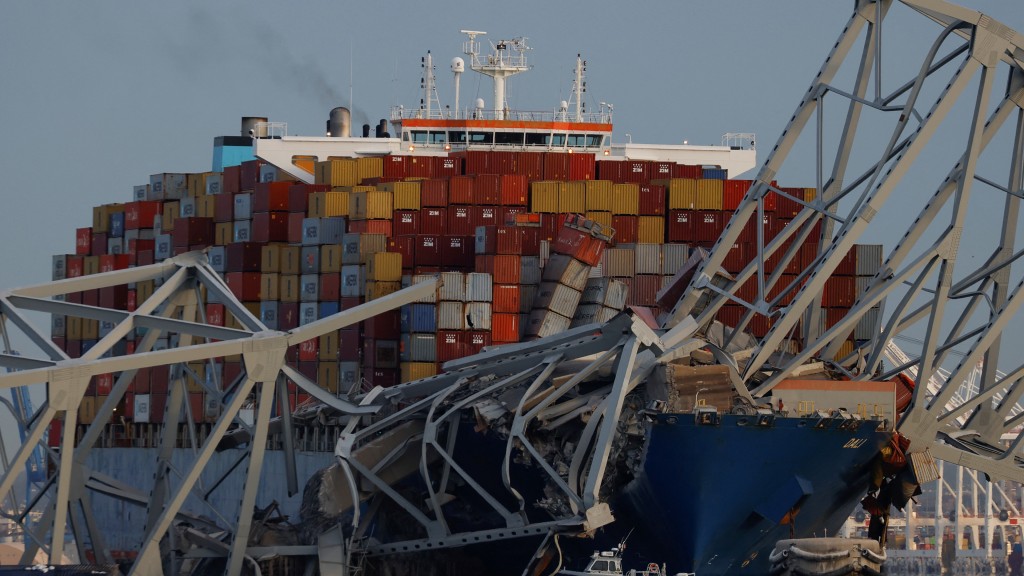美國巴爾的摩大橋被貨船撞塌 多車跌入水中未知傷亡!
鹿特丹斯巴光年
683 回覆
95 Like
4 Dislike
第 1 頁第 2 頁第 3 頁第 4 頁第 5 頁第 6 頁第 7 頁第 8 頁第 9 頁第 10 頁第 11 頁第 12 頁第 13 頁第 14 頁第 15 頁第 16 頁第 17 頁第 18 頁第 19 頁第 20 頁第 21 頁第 22 頁第 23 頁第 24 頁第 25 頁第 26 頁第 27 頁第 28 頁
無啦邊撚到有得救
暫時8個入面搵返兩個,一個冇事一個送院
其餘6個仲搵緊
其餘6個仲搵緊
責任係船東同船長身上
慣左
睇片隻船啲燈熄下著下嘅?engine有事?






橋墩爛左條橋可以唔冧? 咩橋咁厲害?
入錯油





奈河橋


隻船大到咁。。
唔冧就奇
賠到執粒都得

明明就係你懶醒衝出黎柒
原句比返你 踩港踩唔切咁


原句比返你 踩港踩唔切咁



陰公, 有幾多架輛車?
如果老美去更新埋d基礎建設
強國真係車尾燈都見唔到
強國真係車尾燈都見唔到
如果___國____
___國車尾燈都見唔到
___國車尾燈都見唔到

習大大就係想追人gdp 先搞到一大堆鬼城同大白象
內房十年間野蠻生長根本就係政府開綠燈
賣地收入同稅政府袋左幾多
內房十年間野蠻生長根本就係政府開綠燈
賣地收入同稅政府袋左幾多

one ship companies 全世界都好 common,有咩問題 

https://www.elitigation.sg/gd/s/2010_SGHC_18
55 The establishment of one-ship companies within a group of companies is a well-known and legitimate practice in the shipping industry: see The Evpo Agnic [1988] 2 Lloyd’s Rep 411 at 415 (“The Evpo Agnic”). There have been numerous unsuccessful attempts to lift the corporate veil in the context of one-ship companies with common shareholdings and/or directors: see The Evpo Agnic, The Maritime Trader, The Neptune [1986] HKLR 345, The Andres Bonifacio, The Interippu [1990] SGHC 131 (“The Interippu”) and The Skaw Prince [1994] 3 SLR 379. The court may be minded to lift the corporate veil if there are exceptional circumstances which indicate the presence of a façade or sham set up to deceive or to perpetrate a fraud: see The Aventicum, The Saudi Prince [1982] 2 Lloyd’s Rep 255 and Win Line (UK) Ltd v Masterpart (Singapore) Pte Ltd [2000] 2 SLR 98 at 116-117.
https://vlex.co.uk/vid/the-tjaskemolen-v-profer-806548377
It was common for ship-owning groups to arrange their affairs by forming one-ship companies. There was no reason in law why they should not do so without any risk of the arrangements being held to be a sham. The position might be different where a group arranged its affairs in such a way as to divest a company within the group of its assets with the purpose and effect of ensuring that they would not be available to meet its existing liabilities, at any rate where the transfer was made to another member of the group at an undervalue. Depending upon the facts, such an arrangement was likely to be held to be a sham or facade, as those expressions were used in the cases. (The Evpo Agnic [1988] 1 WLR 1090 and Adams v Cape Industries plc [1990] Ch 433; [1990] BCC 786 considered.)
同埋會有 maritime insurance?


https://www.elitigation.sg/gd/s/2010_SGHC_18
55 The establishment of one-ship companies within a group of companies is a well-known and legitimate practice in the shipping industry: see The Evpo Agnic [1988] 2 Lloyd’s Rep 411 at 415 (“The Evpo Agnic”). There have been numerous unsuccessful attempts to lift the corporate veil in the context of one-ship companies with common shareholdings and/or directors: see The Evpo Agnic, The Maritime Trader, The Neptune [1986] HKLR 345, The Andres Bonifacio, The Interippu [1990] SGHC 131 (“The Interippu”) and The Skaw Prince [1994] 3 SLR 379. The court may be minded to lift the corporate veil if there are exceptional circumstances which indicate the presence of a façade or sham set up to deceive or to perpetrate a fraud: see The Aventicum, The Saudi Prince [1982] 2 Lloyd’s Rep 255 and Win Line (UK) Ltd v Masterpart (Singapore) Pte Ltd [2000] 2 SLR 98 at 116-117.
https://vlex.co.uk/vid/the-tjaskemolen-v-profer-806548377
It was common for ship-owning groups to arrange their affairs by forming one-ship companies. There was no reason in law why they should not do so without any risk of the arrangements being held to be a sham. The position might be different where a group arranged its affairs in such a way as to divest a company within the group of its assets with the purpose and effect of ensuring that they would not be available to meet its existing liabilities, at any rate where the transfer was made to another member of the group at an undervalue. Depending upon the facts, such an arrangement was likely to be held to be a sham or facade, as those expressions were used in the cases. (The Evpo Agnic [1988] 1 WLR 1090 and Adams v Cape Industries plc [1990] Ch 433; [1990] BCC 786 considered.)
同埋會有 maritime insurance?



今次真係美國佬搞事...
如果真係咁唯一可以做就係落錨
不過依啲貨船停船沖程好長
落咗都未必一定停到
更何況 船員係咪真係好熟悉落錨個step 都成問題
最大原因 發現得太遲根本冇撚得救
想停嘅時候已經太遲 發動機失控 鈦都可能失控
落咗都未必一定停到
更何況 船員係咪真係好熟悉落錨個step 都成問題
最大原因 發現得太遲根本冇撚得救
想停嘅時候已經太遲 發動機失控 鈦都可能失控
孟婆:喂,今日我啲湯無人買,濟銷啊。
牛頭:無計,奈河橋冧左,過唔到橋,邊有人過黎飲湯?
孟婆:吓?唔撚係啊?奈河橋唔係聲稱話橋墩爛都唔會冧咩?
牛頭:橋墩無爛……係貪污到無安裝橋墩,咁個橋墩爛唔爛,
同條橋咪無關係囉。
孟婆:小喇叭,閰王連呢條橋都貪?
牛頭:閰王唔係官咩?算啦,閰王話搞個盛事,渡海泳,
到時會關照到你啲生意架啦。
牛頭:無計,奈河橋冧左,過唔到橋,邊有人過黎飲湯?
孟婆:吓?唔撚係啊?奈河橋唔係聲稱話橋墩爛都唔會冧咩?
牛頭:橋墩無爛……係貪污到無安裝橋墩,咁個橋墩爛唔爛,
同條橋咪無關係囉。
孟婆:小喇叭,閰王連呢條橋都貪?
牛頭:閰王唔係官咩?算啦,閰王話搞個盛事,渡海泳,
到時會關照到你啲生意架啦。